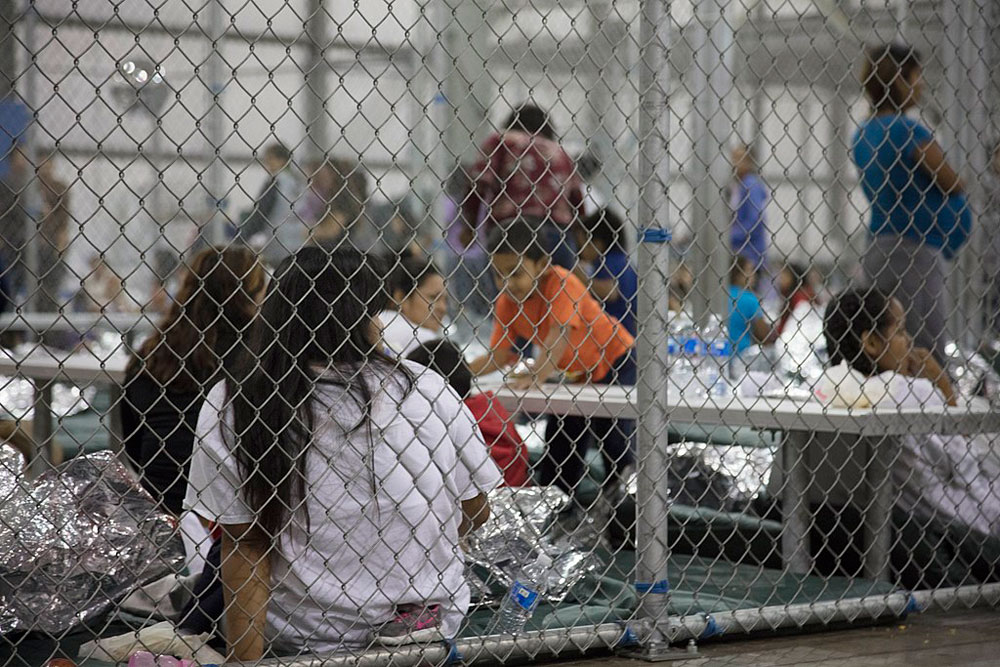
June 22, 2019; New Yorker
The humanitarian crisis involving asylum-seekers—which led to conditions in Clint, Texas, that were described by Caitlin Dickerson last week in the New York Times as a “chaotic scene of sickness and filth”—is largely a crisis of the federal government’s own making.
Yesterday, NPQ carried two articles on the topic. One concerned political negotiations in Congress regarding a possible $4.6 billion allocation; the other, the response of Wayfair workers and their supporters, who said, “Enough!” to facilitating abhorrent government behavior.
The latest atrocity comes on top of so many attacks on immigrants, including travel bans, cuts to refugee and asylum admissions, restricted access to federal benefits, and indefinite detention. That a detention center—which, as Ebony noted earlier this month, is more accurately described as part of a US concentration camp system—would give rise to shameful behavior is no surprise. In fact, the reason Clint was inspected was to ensure federal compliance with the Flores settlement, which mandates that children, if detained, be “held in safe and sanitary conditions” and be released within 72 hours.
Flores dates from 1997, based on a 1987 case. Abuses, clearly, are not new. And, despite Flores, abuses have continued. For instance, a 2018 American Civil Liberties Union (ACLU) report, based on 30,000 pages of records, found that Customs, in detaining children, exhibited a consistent “pattern of intimidation, harassment, physical abuse, refusal of medical services, and improper deportation between 2009 and 2014.”
Still, conditions in Clint were extreme. As Holly Cooper, who co-directs the Immigration Law Clinic at the University of California, Davis, told the Associated Press (AP), “In my 22 years of doing visits with children in detention, I have never heard of this level of inhumanity.” This is true, even though, as AP reporters Cedar Attanasio, Garance Burke, and Martha Mendoza write, “Border Patrol knew the dates of their visit three weeks in advance.”
Warren Binford directs Willamette University’s clinical law program and was at Clint. Binford tells Chotiner that Clint, designed for 104 adults, held 350 children. She adds, “We were shocked by just how many young children there were…and there were child-mothers who were also there….Children described to us that they’ve been there for three weeks or longer.”
Sign up for our free newsletters
Subscribe to NPQ's newsletters to have our top stories delivered directly to your inbox.
By signing up, you agree to our privacy policy and terms of use, and to receive messages from NPQ and our partners.
Most children interviewed, Binford says, were from Guatemala, El Salvador, and Honduras, with a few from Ecuador and one from Peru. Almost all “came across with an adult family member and were separated from them by the Border Patrol. Some of them were separated from their parents themselves; other times it was a grandmother or aunt or an older sibling.”
Binford describes the squalor. The children, she notes, “were filthy dirty, there was mucus on their shirts, the shirts were dirty. We saw breast milk on the shirts. There was food on the shirts, and the pants as well. They told us that they were hungry. They told us that some of them had not showered or had not showered until the day or two days before we arrived. Many of them described that they only brushed their teeth once.”
As for sleeping conditions, many slept “on the concrete floor. They are being given army blankets, those wool-type blankets that are really harsh. Most of the children said they’re being given two blankets, one to put beneath them on the floor. Some of the children are describing just being given one blanket and having to decide whether to put it under them or over them, because there is air-conditioning at this facility.”
Additionally, Binford explains, “we received reports from children of a lice outbreak in one of the cells where there were about 25 children, and what they told us is that six of the children were found to have lice. And so they were given a lice shampoo, and the other children were given two combs and told to share those two combs, two lice combs, and brush their hair with the same combs, which is something you never do with a lice outbreak.”
Binford also emphasized that “children told us that nobody’s taking care of them, so that basically the older children are trying to take care of the younger children.” In the Atlantic, Ashley Fetters explains that children conducting parental duties in the absence of a parent is known as “parentification” and “can affect the function of several of the body’s internal systems and cause severe illnesses, short-term and long-term.”
Now the children are largely out of Clint, but as Stephen Crockett reminds us in The Root, “all of the facilities are inhumane and ill-equipped to handle children”—the concentration camp system, in short, persists. As Masha Gessen in the New Yorker observes, there is a natural human tendency to explain away the unimaginable as aberrant, but “some actual events in our current reality are fundamentally incompatible with our concept of ourselves.”
In Motherly, Heather Marcoux encourages readers to engage politically and lists about a dozen nonprofits that could use support, including San Antonio-based Refugee and Immigrant Center for Education and Legal Services (RAICES). The need for nonprofits, as NPQ’s Cyndi Suarez put it, to “embrace human rights as foundational“ has rarely been more evident.—Steve Dubb













